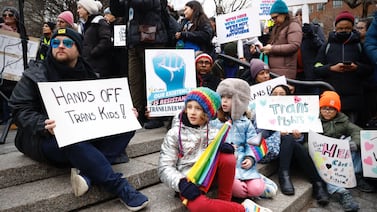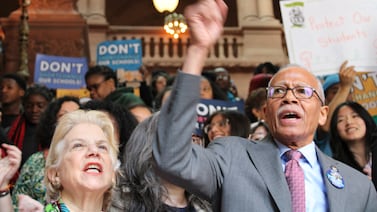This piece is a collaboration between Chalkbeat and THE CITY.
With fewer than a dozen working days left until the legislative session concludes in Albany early next month, Mayor Eric Adams is making his pitch asking lawmakers to extend his control over New York City schools before it expires at the end of June.
But he’s doing it from afar, after scrapping a planned trip to Albany. Privately, some fellow Democrats have griped over Adams’ absence in the halls of the state Capitol as he seeks a four-year extension of mayoral control, according to people familiar with the internal discussions.
Now, he’s promising to visit state legislators “in the next few weeks” to plead the case on why his administration should continue to oversee the city’s school system.
Adams had to cancel a rally planned for last week to drum up support for what’s the first-term mayor is calling “mayoral accountability” after a flight cancellation following a campaign-funded jaunt in Los Angeles, and weather criticism that he’s getting distracted as his administration tries to secure a key win.
He held that rescheduled rally on the steps of City Hall Monday morning, with schools Chancellor David Banks.
“The chancellor and I have laid out a bold new vision for our children and for the families that attend our public school system,” Adams said. “This is the first time in history where we have two men who grew up in the public school system with two different experiences — one dealing with a learning disability, another dealing with the Gifted and Talented program.”
Lawmakers will likely extend mayoral control, but may not give Adams exactly what he’s asking for. They are discussing some tweaks, including a one-year extension, a way for families to get involved in key decisions or coupling mayoral control with a study of its accomplishments in the two decades since its been implemented — something the principals union has been seeking.
“The likely outcome will be a system in which the mayor still has control, and therefore, we can hold him accountable for school success or failure, but a system that also provides a meaningful mechanism to bolster parental input,” said Queens Democratic Sen. John Liu, who chairs the Senate’s committee on New York City education. “That is the main issue — that parents feel they have no way to engage, that their suggestions and complaints aren’t even heard.”
‘Stability and Surety’
Well into the third school year defined by a pandemic that interrupted learning and thrust educators and kids into new forms of schooling, Adams argued that extending mayoral control is needed to provide some consistency.
“After two years of trauma to our students, uncertainty cannot be part of the curriculum. It needs to be stability and the surety that these young people are going to know what is going to happen in the upcoming school year,” the mayor said at Monday’s rally.
To be sure, the Adams administration faces multiple challenges over his next four years in office with the nation’s largest school system. Schools and educators are continuing to bounce back mentally and academically from the pandemic. While the education department has so far refused to disclose data from its own assessments of student learning gaps, national test scores released in July 2021 showed that the typical student was behind in reading and math, with steeper drops among Black, Latino and Native American students, as well as children in low-income schools.
Chronic absenteeism — when students miss more 10% or more school days — reached its highest levels this school year since at least 2000, according to education department data.
Enrollment has dropped by 6.4% since the 2019-2020 school year, when the pandemic started. Further dips in enrollment could push Adams to make controversial decisions on closing schools, though the mayor said recently that he’s not currently considering closures.
Adams did not share much insight into what his administration plans to do with an additional four years of mayoral control. Instead, he pointed to what he considered successes under past mayors: the creation of universal pre-K under former mayor Bill de Blasio and rising graduation rates. (Graduation rates have risen across the nation since the early 2000s for mixed reasons until the pandemic hit, and in New York, changes at the state level have helped boost those figures.)
Asked for specifics about what types of policies or items City Hall would pursue if granted mayoral control, spokesperson Fabien Levy reiterated Adams’ talking points about previous administration’s achievements, ideas that he said “are at risk without mayoral accountability.”
Education department spokesperson Nathaniel Styer pointed to an address in March by Banks, where the chancellor discussed his vision for expanding virtual learning options, changing how the system teaches students to read, giving principals more autonomy, and providing more exciting programs for students, such as career and technical education.
So far, the Adams administration has announced an expansion of the Gifted and Talented program (the opposite of what de Blasio wanted to do), broader summer programming and jobs for youth and a slew of decisions over COVID safety, such as providing more at-home test kits and lifting the mask mandate for K-12 schools.
What could changes to mayoral control look like?
Mayoral control of schools became part of state law in 2002 but has never been permanent, offering Albany officials a chance to exert some power over the state’s biggest metropolis. It forces mayors to make the trek north and plead for an extension, sometimes involving political bartering.
It’s been extended every few years with a sunset date. Mayoral control was last extended in 2019 under Blasio.
But even though it’s been continuously extended, it hasn’t always been easy.
De Blasio nearly lost the power when Black and Latino lawmakers in 2019 said that the then-mayor was unresponsive to their questions over mayoral control, prompting the mayor to make a last-minute trip to the state Capitol. In 2017, the deal to extend mayoral control was tied to an increase in the number of charter schools, a concession to Republicans who controlled the State Senate.
Although Democrats now control both chambers, lawmakers and political observers believe mayoral control will be extended, in part because there’s not enough political will or time to find a replacement for the system before the June 30 expiration, or to revert to the former system of 32 community boards.
But the governance system may not receive the four-year extension that Gov. Kathy Hochul and Adams have called for, covering Adams’ entire first term in office.
Liu said that it doesn’t appear likely that Adams will get a straight four-year extension.
According to Albany sources there doesn’t appear to be enough support among lawmakers to secure that win for Adams. Instead, lawmakers are still discussing how to forge a path forward, said State Rep. Michael Benedetto, a Bronx Democrat who chairs the chamber’s education committee.
“Right now we’re kind of in flux and we’re still searching for ideas,” said Benedetto, a former teacher.
An extension could be coupled with adding more members or watering down the mayor’s power over the 15-person Panel for Educational Policy, or PEP, a mostly mayorally appointed board that votes on major school policies and contracts.
A mayoral rubber stamp no more?
The mayor’s power primarily operates in two ways: He chooses the city’s schools chancellor, and he appoints a majority, or nine, members to the PEP. Borough presidents choose an additional five, and the city’s 32 parent councils elect a representative — a change that came about as part of the concession in extending mayoral control in 2019.
While this board has often been seen as a mayoral rubber stamp, Adams’ failure to choose all nine of his appointees has resulted in the rejection of two of his administration’s recent proposals. In a vote last month, the panel rejected the city’s school funding formula over concerns that it’s not equitable enough, raising concerns that schools would get late budgets for next year.
One of Adams’ choices for the board was forced to resign after the New York Daily News revealed her anti-gay writings. The administration has not yet replaced that seat.
Asked Monday why the Legislature should trust him with mayoral control since he’s failed in his duty to appoint all nine members, Adams said he wants to “get it right.”
“We have to get it right because when you lay a foundation, you don’t have to come back and revisit it all the time,” Adams said, adding that he expects the school chancellor to make an announcement about a new appointee in the coming days.
Many lawmakers, parent advocates and the city’s teachers union are interested in giving families more say in the system through the PEP. To achieve that, Liu said he’s heard several proposals, including adding more members to the PEP who would be elected by local parent councils or giving the mayor one appointment shy of a majority of the board. That would require the mayor to solicit the support of at least one non-mayoral appointee to get his proposals passed.
Liu has also heard proposals to give PEP members fixed terms so that they cannot be removed for any reason from the board. The teachers union has called for one-year terms.
Currently, the mayor and borough presidents can remove their appointees at any time, and must provide written public notice explaining the reasons for removal at least 10 days in advance. Former Mayor Michael Bloomberg and the Staten Island borough president at the time famously removed PEP members in 2004 after some opposed Bloomberg’s plan on how to promote third graders.
Some of those proposals seem like possibilities to State Rep. Jo Anne Simon, a Brooklyn Democrat who sits on the Assembly’s education committee, who said she would also support more PEP members who represent specific types of high needs students, such as those with disabilities and those who are homeless, as well as an audit of mayoral control’s impact on student learning over the past 20 years.
Since Adams has only been mayor for four months, a three-year extension would be better suited, said Benedetto, giving the mayor enough time to implement reforms but also allowing the Legislature to be a check.
“When we elect a mayor of the city of New York and we give them this power, we must be vigilant and continually look to see if they’re doing the right thing and how that plays out over a number of years,” Benedetto added.
“I don’t know if he will get everything he wants,” he said of Adams’ four-year extension. “People are usually optimistic on such matters but their optimism sometimes doesn’t come to be. So, will he get it? That remains to be seen.”
THE CITY’s Katie Honan contributed.







